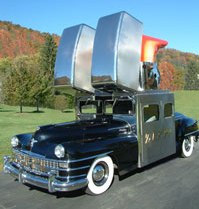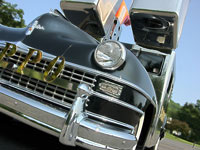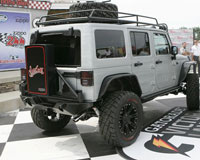-

The history of Zippo Manufacturing Company is the story of its people. From its founder George G. Blaisdell, to the many Zippo employees, customers, and collectors who have all played a vital role in the company’s rich history. Their loyalty and dedication has made Zippo one of America’s greatest and most recognizable icons.
The Zippo timeline begins in the early 1930s, at the Bradford Country Club in Bradford, Pennsylvania. Mr. Blaisdell watched a friend struggle awkwardly to use a cumbersome, Austrian-made lighter. Mr. Blaisdell noted that the lighter worked well, even in the wind, due to the unique chimney, but the appearance and design was utilitarian and inefficient. The lighter required the use of two hands to operate and its thin metal surface was easily dented.
In late 1932 Mr. Blaisdell decided to reconstruct the Austrian lighter. He fabricated a small rectangular case and attached a lid with a hinge. He preserved the chimney design which protected the flame. The result was an attractive lighter that was easily operated with one hand. The name “Zippo” was created by Mr Blaisdell. He liked the sound of the word “zipper” so he formed variations on the word until he settled on “Zippo,” which he felt had a “modern” sound.
The new lighter sold for $1.95 each and was backed by Mr. Blaisdell’s, now famous, unconditional lifetime guarantee –"It works or we fix it free.™” The application for the original Zippo patent was filed on May 17, 1934, and patent number 2032695 was granted on March 3, 1936. That first Zippo lighter, produced in 1933, is on display at the Zippo/Case Museum in Bradford.
In the mid-30’s, Kendall Refining Company in Bradford, placed an order for 500 Zippo lighters. These lighters are believed to be the first company-advertised lighters produced by Zippo and are highly prized collectibles.

World War II had a profound impact on Zippo. Upon America’s entry into the war in 1941, Zippo ceased production of lighters for consumer markets and dedicated all production to the U.S. military. This initiative led to the production of the steel-case Zippo lighter with black crackle finish. The fact that millions of American military personnel carried the lighter into battle was a significant catalyst in establishing Zippo as an American icon throughout the world. Supplying the military market resulted in full production for the plant and enabled Zippo to become financially strong and made it a viable company.
GET ONE OF OUR 1941 BLACK CRACKLE REPLICA LIGHTERS
1941 Black Crackle Replica
BUY NOW
At the end of the war in 1945, Zippo returned to selling lighters to a peacetime America and resumed producing lighters for the consumer market. A promoter at heart, Mr. Blaisdell wanted to hit the road with a car that looked like a Zippo lighter and in 1947 the Zippo Car was born.
On August 1, 1950 Zippo was issued its second patent, number 2517191. The design of the Zippo lighter remains basically the same to this day, with minor improvements.
Beginning in the mid-50’s, date codes were stamped on the bottom of every Zippo lighter. The original purpose was for quality control, but the codes have become an invaluable tool for collectors.
In 1956 Zippo launched the Slim lighter, which was a major milestone. This slightly smaller version of the Zippo lighter was designed to appeal to women but much to his surprise also appealed to men.
1960s
In the 1960’s concert-goers began raising the Zippo flame as a salute to favorite performers, a gesture later dubbed the “Zippo Moment.”
In 1962 Zippo produced its first non-lighter product. The steel pocket tape measure, or “rule,” as it was called, had a design that resembled the famous lighter. Other items have been added and deleted from the Zippo line since the 1960s. Many were primarily geared to the promotional products division including key chains, golf greenskeepers, pen-and-pencil sets and the ZipLight pocket flashlight.
1970s
Mr. Blaisdell passed away on October 3, 1978. He is remembered not only for inventing the Zippo lighter, but also for his generosity and kind spirit. After his passing, his daughters, Harriett B. Wick and Sarah B. Dorn, inherited the business.
During the 1970s Zippo began expanding to overseas markets.
Blaisdell
1980s
In the 1980s the company was owned by six members of the Blaisdell family, including Mr. Blaisdell’s daughters and their children.
1990s
In 1993 Zippo acquired W.R. Case and Sons Cutlery Company. Case’s rich heritage began when it was founded in 1889. The company moved to Bradford in 1905. Case manufacturers premium hand-crafted knives including traditional folding pocket knives and fixed blade sporting knives to limited-edition commemoratives and collectibles.
The Zippo/Case Museum opened in July 1997. The 15,000-square-foot facility includes a store and museum. It is also home to the world-famous Zippo Repair Clinic, where visitors can watch the repair process take place.

2010s
In the fall of 2002, Zippo obtained trademark registration for the shape of the Zippo lighter. This was a major milestone to help protect the brand from counterfeiters.
Also in the early 2000’s Zippo launched the first Zippo MPL®, multi-purpose lighter, a refillable utility-style lighter.
GET ONE OF OUR MULTI-PURPOSE LIGHTERS
Candle Lighter
CANDLE LIGHTER
Flex Neck Lighter
Register as Zippo members to get more surprises!
Register

